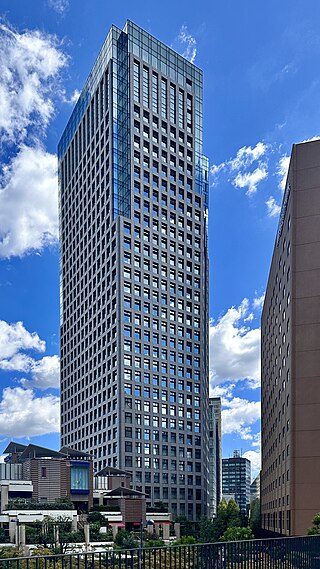KDDI
Japanese telecommunications operator From Wikipedia, the free encyclopedia
KDDI Corporation (KDDI株式会社, KDDI Kabushiki Gaisha) (TYO: 9433) is a Japanese telecommunications operator. It was established in 2000 through the merger of DDI (第二電電, Daini Denden), KDD (ケイディディ), and IDO (日本移動通信, Nippon Idō Tsūshin). In 2001, it merged with a subsidiary named Au, which was formed through the merger of seven automotive and mobile phone companies from the DDI-Cellular Group. As of 2020, it is the second-largest mobile telecommunications provider in Japan in terms of the number of contracts, following NTT Docomo.
This article needs additional citations for verification. (May 2022) |
You can help expand this article with text translated from the corresponding article in Japanese. (October 2024) Click [show] for important translation instructions.
|
 | |
 Headquarters in Iidabashi, Chiyoda, Tokyo | |
Native name | KDDI株式会社 |
|---|---|
Romanized name | Keidīdīai kabushiki gaisha |
| Formerly | DDI Corporation (1984–2000) |
| Company type | Public KK |
| TYO: 9433 TOPIX Core 30 Component | |
| Industry | Telecommunications |
| Predecessor | KDD Corporation IDO Corporation |
| Founded | 1953 (establishment of Kokusai Denshin Denwa or KDD as a state-owned enterprise)[1][2] June 1, 1984 (as DDI) |
| Founder | Government of Japan (for the KDD branch) Kazuo Inamori (for the DDI branch) |
| Headquarters | Iidabashi, , |
Key people | Takashi Tanaka (businessman) (CEO) Makoto Takahashi (businessman) (President & CEO) |
| Products | Fixed line and mobile telephony, Internet services, digital television |
| Revenue | JP¥ 5.24 trillion (2020)[3] |
| JP¥ 639.77 billion (2020)[3] | |
Number of employees | 44,952 (2020)[3] |
| Subsidiaries | List
|
| Website | www.kddi.com |
KDDI provides mobile cellular services using the Au brand. ISP network services are provided under the au one net brand, while "au Hikari" is the name under which long-distance and international voice and data communications services and Fiber to the Home (FTTH) services are marketed. ADSL broadband services carry the brand name "ADSL One", and IP telephony over copper is branded as "Metal Plus".
History
Summarize
Perspective
On April 1, 2002, au by KDDI launched 3G networks using CDMA2000 1x technology.[citation needed]
On November 28, 2003, au by KDDI launched EV-DO Rev 0 service in the "CDMA 1X WIN" brand, and revolutionized Japan's mobile telecommunication industry by introducing fixed rate data subscription plans at a data rate of 2.4 Mbit/s.[citation needed]
In December 2006, au by KDDI became the first carrier to provide an EV-DO Rev A service at a data rate of 3.1Mbit/s (downlink), 1.8 Mbit/s (uplink).[citation needed]
au by KDDI has been very successful with its EZ wireless data services, EZweb, EZweb@mail, EZappli, EZchakuuta, ezmovie, and EZnaviwalk (GPS), using the advanced WAP technology. It supports both Java ME and BREW application environments.[citation needed]
In November 2004 au by KDDI introduced the music include ringtone download service Chaku Uta Full (music ringtone full), for download of full length songs to mobile phones. Within six months from introduction, on June 15, 2005, customers had downloaded 10 million full length Chaku Uta Full songs.[citation needed]
As of end of June 2005, au by KDDI has 20,122,700 customers, among which 18,723,200 (93%) are 3G CDMA2000 subscribers. It is Japan's second-largest cellular operator with an increasing 20.0% market share.[citation needed]
On January 26, 2006, the first pointing local search application, Mapion Local Search - Powered by GeoVector, was launched on the KDDI network on their GPS and compass equipped handsets.[4] In January 2007, KDDI announced its ten new 3G models for spring 2007, and a concept of its new designer phone Media Skin by Tokujin Yoshioka which would later be displayed at the Museum of Modern Art in New York with the Infobar, Talby and Neon models. Toshiba, Casio, Sanyo, Kyocera, Hitachi, Sony Ericsson, Sharp, and Panasonic have manufactured the other models.[5] In March 2007, Media Skin started selling.[6]
KDDI announced that it would collaborate with the Taiwanese manufacturer HTC Corp. to sell the mobile phone HTC J in Japan starting May 2012. The HTC J mobile phone featured the Android 4.0 operating system.[7][8]
On October 21, 2011, KDDI buys Content Delivery Network CDNetworks For $167 Million.[9]
KDDI together with Sumitomo Group signed an agreement with Myanmar State owned Myanmar Post and Telecommunication (MPT) in July 2014 to jointly operate a mobile phone service in Myanmar for next 10 years.[10]
Consumer showroom is set in Harajuku called, "KDDI Designing Studio".
TU-KA (TU-KA by KDDI), a subsidiary company of KDDI, was a 2G PDC cellular operator in three metropolitan areas (Tokyo, Nagoya, and Osaka), which did not apply a 3G license. TU-KA was best known for having singer Ayumi Hamasaki to appear in their commercials. TU-KA was closed on March 31, 2008.
DDI Pocket, a PHS operator, was previously owned by KDDI but was spun off as Willcom which is now incorporated into Y!Mobile.
In August 2014, KDDI announced it was joining forces with five other global companies, including Google to build a 60 Tbit/s undersea data transmission cable linking the United States West Coast and Japan.[11] The cable started operation in June 2016.[12]
KDDI and Ericsson began working together in December 2015 in order to research and develop 5G technology.[13]
Lawsuits
In 2003, several class action complaints were filed against DDI for misrepresenting and/or failing to disclose material facts about the company's financial results.[14] The parties agreed on a $4.4 million settlement in 2006.[15]
See also
- au
- KDDI Mobile
- G-Book, a telematics service provided by Toyota in Japan only
- KDDI India Private Limited
- List of telephone operating companies
References and footnotes
Wikiwand - on
Seamless Wikipedia browsing. On steroids.
